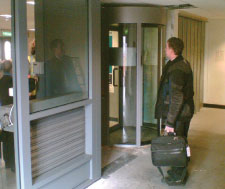
Lee Hannis, business development manager, Human Recognition Systems: “Iris scan is a huge step forward in not only improving security but also providing an automated system.”
The biometric access control system enables Manchester airport to transit staff – of which it employs more than 25,000 – from airside through to landside safely and securely. All Manchester airport restricted zone pass holders must be enrolled on the new system by summer 2008.
The single person volumetric access control portals, provided by Human Recognition Systems, are combined with iris recognition cameras to verify staff identity and enhance the manual checks already in place.
Iris scans can compare more than 200 points of the human eye in the coloured tissue surrounding the pupil, including rings, furrows and freckles. By combining computer vision, pattern recognition, statistical inference, and optics, the iris scan analyses then stores a biometric template.
Lee Hannis, business development manager, Human Recognition Systems, said: “Iris scan is a huge step forward in not only improving security but also providing an automated system. The swipe and enter principle, which is used at many security checkpoints, can be cumbersome and slow, with the added disadvantage of human error. The iris technology does not get tired, bored or distracted and as the information is not transferable, it positively proves the identity of the person presenting their eyes. It has never had a false acceptance and once captured, the biometric template lasts for life.”
He estimates that a potential £100,000 (€130,000) worth of man-hours could be saved by using such automated technology, enabling skilled workers to be reassigned to conduct more “human tasks”.
Counteracting weaknesses
Staff using the new entry points will continue to use and display their ID cards. They will swipe their card and enter a personal PIN number before entering a booth where a specialised camera will check their iris. The iris information is being held on a secure access control system operated only by the airport’s pass office.
“The whole process is new for both the airport and passengers, which means there may be a slight degree of resistance in the initial stages. It is essential to employ an educational process that ensures a good level of communications is delivered to minimise the disruption as people learn and conform to the new routine,” said Hannis.
Enrolment is another potential difficulty, as Hannis described enrolling the 25,000 employees at Manchester airport as a “great undertaking”. He explained: “This too can be counteracted by simply aligning the new security processes with the old, so that when people pick up their swipe card, they also enrol for the iris check.”
There are no current plans to extend the iris biometric technology to the passenger process.
“Right now, the business drivers of the system in use for the staff at Manchester airport are very obvious – it improves security and reduces costs. The business drivers for implementing a passenger process are completely different, as it would incur a cost and it would involve an extensive and complicated enrolment process. It would also need to be across many airports in order to be effective, which itself would require a consensus of multiple partners,” said Hannis.







